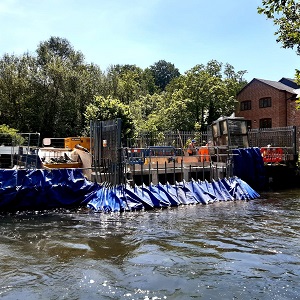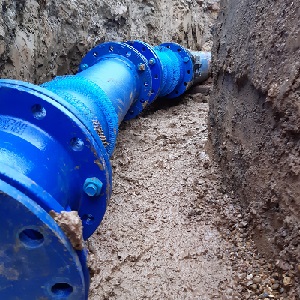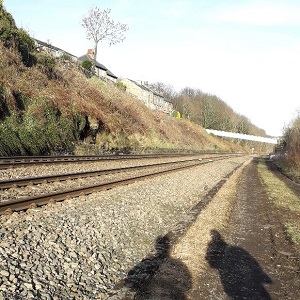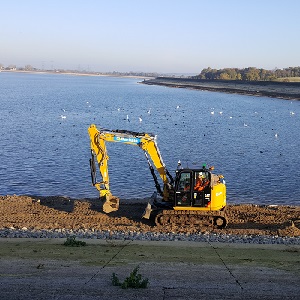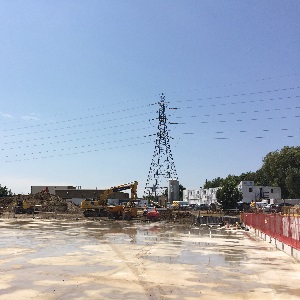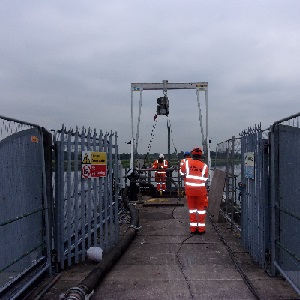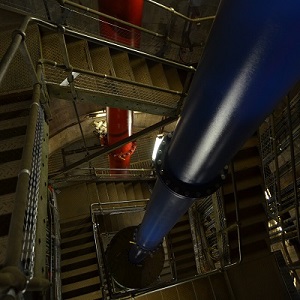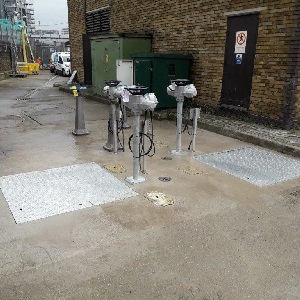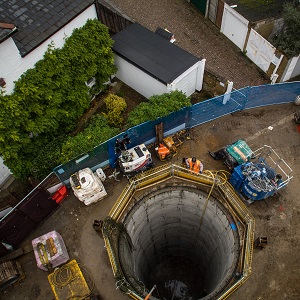Barhale was contracted by Portsmouth Water to design and build
appropriate infrastructure at its abstraction intake on the River Itchen.
The scheme aimed to align the structure with the recently imposed
England and Wales Regulations (Eel), whilst also screening for Brook
Lamprey.
To achieve this, 4No. S1800 Hydrolox screens were retrofitted to the
existing intake structure in place of the existing raked course bar
screens. This required structural modifications and an additional
cantilevered 12m walkway over the river for maintenance access.
Category: Water & Utilities
Mandeville Road Water Diversion
As part of Barhale’s framework with Affinity Water to divert and
protect the latter’s assets along the HS2 route, Barhale were
contracted to replace and reinforce sections of an existing strategic
12” main between the Affinity Water Northolt Booster site and
Greenford Park Estate.
The reinforcement of the strategic main will
ensure sufficient water supply to two maintenance shafts that will be
built by HS2’s main works contractor in the area. The works on site
started in September 2019, and they are due to finish towards the end of 2020.
Britannia Road – Collapsed Sewer Under Railtrack
Network Rail informed Yorkshire Water that foul sewage was leaking
to the surface and onto the railway track. After CCTV investigation and attempts at unblocking the pipeline, it was found that the 225mm
diameter foul sewer had collapsed due to its 100 year old age and
ground pressure caused by the trains. The sewer was shallow at only
1.5m depth and had been affected by a Network Rail track drainage
project.
Following an optioneering process, the damaged sewer was reinstated at its existing alignment and was relayed in sections, with live flows. This required the use of a temporary overpumping system.
The sewer line crosses the main MVL3 Manchester to Huddersfield line, so the works were carried out over a series of short Rules of Route (ROR) night possessions.
King George V Reservoir Works
King George V Reservoir was constructed between 1908 and 1912.
It opened in 1913 and is the largest reservoir within the London area, measuring 170 ha (420 acres) in size and holding 2,740,000,000 gallons of water. To enable the reservoir to continue to operate safely, Barhale were engaged by eight₂O (SMB JV) to carry out two essential elements of work:
- Strengthening of the existing kneeler beam
- Installation of a hardcore access road round the crest of the reservoir
Kneeler beams are built into the upstream shoulders of the reservoir
embankment. They provide support to the concrete slabbing, which
protects the embankment from wave erosion around the top of the
water level. When reservoir levels were very low, there was the risk
of erosion undermining these kneeler beams, which could cause the
concrete slabs to fall away.
Coppermills Water Treatment Works Upgrades
As part of the upgrades at Coppermills Water Treatment Works,
Barhale were contracted by eight₂O to undertake the civil works for
the installation of 12 Rapid Gravity Filter Tanks (RGF Tanks), construct
a new weir chamber and pipework to two adjacent pipe galleries and
install new draw pits and ducting for HV/LV cables running into the
newly constructed MCC base slab. These upgrades will significantly
improve water purification capacity into Thames Water’s Ring Main,
and help to meet the demands of London’s rising population.
The scope of work on this project included all the earthworks for the
installation of the RGF Tanks and North and South pipe galleries. The
initial work plan required us to excavate the pipe galleries before
constructing the piling mat between them.
Warwick Tunnel Inspections
As part of eight₂O’s Tunnels and Aqueducts Programme, Barhale conducted the enabling works for tunnel inspections by Thames Water engineers. This included:
- Structural integrity surveys of specified tunnels
- Designing, supplying and installing secondary isolation
- Tunnels drainage and cleaning
- Primary inspection of tunnels
After Thames Water engineers inspected the tunnels, Barhale also carried out the required repairs. The scope of work covered 4 tunnels of which significant sections had been built in the 1800s. The tunnels were accessed via 5no shafts (3m ID, and depths ranging from 16 to 25m), which were located inside the reservoirs. The reservoirs themselves are situated on land that is open to public access via the Wetlands project.
Laser scanning covers the points (Featured in Tunnels and Tunnelling)
The Thames Water Ring Main (TWRM) was one of the engineering achievements of the 1980s. Some 80km of concrete pipeline, mostly 2.54m in diameter, surrounds the capital and acts simultaneously as a reservoir and as a distribution system, supplying around 3.5 million Londoners. At the time of its construction, the TWRM was the longest tunnel in the UK – longer by 30km than the Channel Tunnel, which had opened less than six months earlier.
It was excavated by TBM, mainly through the easily-tunnelled and forgiving London clay – though at one point under Tooting Bec Common it unexpectedly passed through a bed of the Thanet Formation, which led to flooding and the temporary abandonment of a TBM.
The initial ring main was constructed by Thames Water between 1988 and 1993. Extensions and branches have been constructed, and further extensions are planned.
Battersea Chamber
As part of a pressure management scheme for Thames Water, Barhale
were contracted to carry out improvement works on 2no water mains
within a Thames Water compound on Cringle Street, near Battersea
Power Station. The works entailed replacing sections of old pipework
and the installation of new plug valves on both Putney and Crouch
Hill mains, and the construction of a new chamber for the pipework.
These works allow Thames Water to better monitor and manage the
pressure inside their water distribution network and thus to create an
accurate profile for the pressure management of clean water for this
area. This will ultimately result in more efficient asset management
and an improved water supply for Thames Water’s customers.
Counters Creek Flood Alleviation Scheme
The Counters Creek Flood Alleviation Scheme (CCFAS) was developed
following widespread basement flooding caused by intense rainfalls
in the Royal Borough of Kensington and Chelsea and the London
Borough of Hammersmith and Fulham. Thames Water appointed
Barhale to design and construct the local sewer upgrades. The scope
of works, which covered seven local schemes, included the installation
of new sewers, the construction of two new pumping stations and
sewer networks, and the installation of three FLIP devices utilising
Combi approved systems.
The original design raised several challenges, including closure of
main roads in a densely populated area, importing approx. 2000t
aggregates and removal of 1800t of spoil, and potential settlement
issues affecting nearby structures and utilities. Barhale proposed a
new, innovative and cost-effective design and safely completed the
project by June 2020, in line with Thames Water’s commitment.
Brentford Waterside Sewer Diversion
Barhale were required to install a new sewer system to facilitate the
construction of a mixed use residential and retail development, on a
4.79 hectare brown field site in Brentford, west London.
Barhale’s works involved the installation of 190m of new 600mm
diameter concrete pipeline, along with 6no 1500mm diameter
manholes along the run. This will enable flows from the new
development to tie into the existing Thames Water network.
All works were undertaken via open cut techniques. The pipeline was
installed at depths of between 3.5 – 4.5m throughout the site, using a
combination of methods, including:
• Drag boxes
• Trench boxes
• Trench sheets and frames
